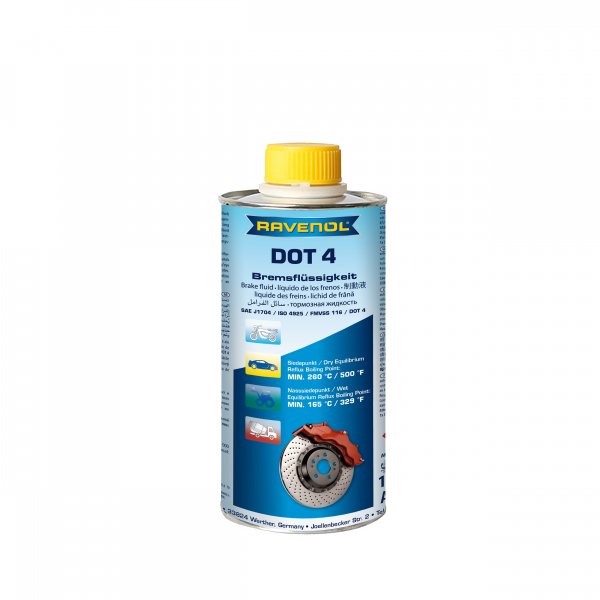RAVENOL DOT 4 is a brake fluid for the use in all vehicles with optimum ABS characteristics. There is a chemical stability and it is provided with additives which save the best lubrication efficiency.
Because of the special formulation of RAVENOL DOT 4 the international specifications SAE J 1704, ISO 4925 and the safety regulations FMVSS 116 DOT 3 and DOT 4 from the United States of America are exceeded.
Application Note
RAVENOL DOT can be used in all vehicles for which the DOT 4 specification for brake fluids is required. It is suitable for all hydraulic brake systems with synthetic fluids.
RAVENOL DOT is miscible with all known brake fluids of the same specification. To use the high performance level of RAVENOL DOT , a complete change of the brake fluid is recommended.
RAVENOL DOT is not suitable for vehicles with mineral oil systems (e.g. certain Citroën models).
FOLLOW VEHICLE MANUFACTURERS RECOMMENDATIONS WHEN ADDING BRAKE FLUID KEEP BRAKE FLUID CLEAN AND DRY. Contamination with dirt, water, petroleum products or other materials may result in brake failure or costly repairs.
STORE BRAKE FLUID ONLY IN ITS ORIGINAL CONTAINER. KEEP CONTAINER CLEAN AND TIGHTLY CLOSED TO PREVENT ADSORPTION OF WATER. CAUTION! DO NOT REFILL CONTAINER AND DO NOT USE FOR OTHER LIQUIDS.
Dispose of used brake fluid responsibly (EU waste code 160113).
Brake fluid damages paint work –if spilt wash off immediately with plenty of water.
Characteristics
- optimum ABS characteristics
- chemical stability
- best lubrication efficiency
- neutral behaviour regarding brake parts
- low viscosity at low temperatures
- miscible with all brake fluids of the same specifications
Technical Product Data
| Property | Unit | Data | Audit |
|---|---|---|---|
| Density at 20 °C | kg/m³ | 1052,0 | EN ISO 12185 |
| Colour | hellgelb | VISUELL | |
| Viscosity at 100 °C | mPa*s | 2,41 | ASTM D445 |
| Viscosity at -40 °C | cSt | 1340 | ASTM D445 |
| Boiling point | °C | 271 | FMVSS 116 |
| Wet Equilibrium Reflux Boiling Point | °C | 169 | FMVSS 116 |
| High Temperature Stability | °C | -1 | FMVSS 116 |
| Chemical Stability | °C | +1 | FMVSS 116 |
| Evaporation | %w/w | 61 | FMVSS 116 |
| Fluidity & Appearance at -40 °C | i.O., 4s | FMVSS 116 | |
| Fluidity & Appearance at -50 °C | i.O., 8s | FMVSS 116 | |
| Water Tolerance at -40 °C | klar, 3s | FMVSS 116 | |
| Water Tolerance at +60 °C | klar, keine Ablagerungen | FMVSS 116 | |
| Compatibility at -40 °C | klar, keine Phasentrennung | FMVSS 116 | |
| Compatibility at +60 °C | klar, keine Ablagerungen | FMVSS 116 | |
| Water content | mg/kg | <0,2 | DIN 51777-1 |
| Tinned Iron | Δ mg/cm² | +0,04 | FMVSS 116 |
| Steel | Δ mg/cm² | -0.01 | FMVSS 116 |
| Aluminium | Δ mg/cm² | +0,02 | FMVSS 116 |
| Cast Iron | Δ mg/cm² | -0,03 | FMVSS 116 |
| Brass | Δ mg/cm² | -0,08 | FMVSS 116 |
| Copper | Δ mg/cm² | -0,05 | FMVSS 116 |
| Zinc | Δ mg/cm² | +0,01 | FMVSS 116 |
| Sediment | % | <0,05 | FMVSS 116 |
| pH - value | 8,20 | FMVSS 116 | |
| Rubber Diameter Change | +0,16 | FMVSS 116 | |
| Hardness Change | °IRHD | -4 | FMVSS 116 |
| Appearance | i.O. | FMVSS 116 | |
| SBR at 70 °C | Ø Δ, mm | +0,56 | FMVSS 116 |
| SBR at 120 °C | Ø Δ, mm | +0,73 | FMVSS 116 |
| EPDM at 70 °C (as required by SAE J1703) | Δ Härte | -2 | FMVSS 116 |
| EPDM at 120 °C | Δ Härte | -2 | FMVSS 116 |
| Natural at 70 °C (as required by ISO 4925) | Ø Δ, mm | +0,38 | FMVSS 116 |
All indicated data are approximate values and are subject to the commercial fluctuations.




